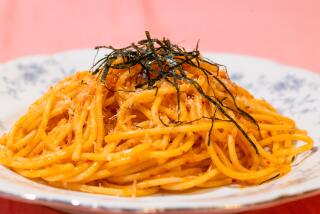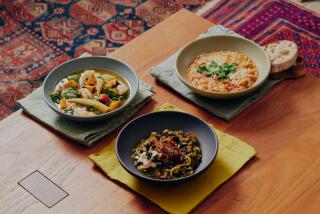Shrimp: The Little Scampi
During the asparagus season, I love to toss some briefly cooked asparagus with sauteed shrimp and garlic for a springtime version of shrimp scampi. I also like to spoon shrimp scampi over a salad of baby spinach or mixed European greens and serve it as an elegant appetizer.
Scampi, to be precise, does not mean shrimp but is the Italian name for small members of the lobster family, also known as Dublin Bay prawns, Norway lobsters or, in French, langoustines.
If you consider the name “shrimp scampi” literally, it doesn’t make much sense; it’s like saying “shrimp lobster.” Its usage probably began when Italian chefs in the United States substituted shrimp in a recipe that normally called for scampi and probably referred to it as shrimp prepared scampi-style. Eventually it was shortened to “shrimp scampi” or simply “scampi.”
Scampi became a popular term for shrimp prepared according to a specific formula: sauteed with garlic and often accented with Italian parsley and white wine or lemon juice.
Real scampi are rare in the United States, whereas shrimp are abundant and easier to prepare. Indeed, shrimp scampi is an ideal dish for quick cooking. Shrimp require only two to three minutes to cook. You do need a few more minutes to shell the shrimp, unless you buy them already shelled.
When you prepare shrimp scampi in your own kitchen, you have control over what goes into the dish. Restaurant cooks often use large quantities of fat to saute the shrimp. Some recipes call for excessive amounts of butter, as much as 1 1/2 sticks for a pound of shrimp. I find you can make healthful yet delicious shrimp scampi with a modest amount of extra-virgin olive oil.
The dish will taste best if you take care in cooking the shrimp and the garlic. When sauteing the shrimp, stir often so all sides turn pink, then cut into the thickest part of one shrimp to be sure the color inside is white. Add the garlic part way through the shrimp’s cooking time, so that the garlic does not turn dark brown and bitter but still has enough time to lose its raw taste, 30 to 60 seconds.
From shrimp scampi you can make other wonderful dishes. With or without asparagus, shrimp scampi is great tossed with linguine, fettuccine or cooked rice. My favorite chef in France, Fernand Chambrette, uses garlic shrimp as a topping for a fabulous seafood pizza.
SHRIMP SCAMPI WITH ASPARAGUS (VEGETARIAN; 30 MINUTES OR LESS)
Once you begin sauteing the shrimp, everything moves quickly, as in a stir-fry.
1 pound thick asparagus, peeled and trimmed
2 tablespoons extra-virgin olive oil
1 pound shrimp, shelled and deveined
Salt, freshly ground black pepper
Cayenne pepper
3 large cloves garlic, minced
2 tablespoons chopped parsley, preferably flat-leaf
Lemon quarters for garnish
Cut each asparagus spear into 3 pieces and boil in medium saucepan in water to cover until tender, about 4 minutes. Drain, reserving cooking liquid.
Heat oil in large skillet. Add shrimp, season to taste with salt, black pepper and cayenne pepper and saute, stirring, over medium-high heat 1 1/2 minutes. Add garlic and saute, stirring, until shrimp are cooked through, about 1 minute. To check for doneness, cut into 1 shrimp; it should be white inside.
Add 1/4 cup asparagus cooking liquid to skillet and bring to boil, stirring. Stir in parsley, then add asparagus and heat through briefly. Serve with lemon quarters.
3 main-course or 6 first-course servings. Each main-course serving:
246 calories; 282 mg sodium; 184 mg cholesterol; 11 grams fat; 8 grams carbohydrates; 29 grams protein; 1.36 grams fiber.


